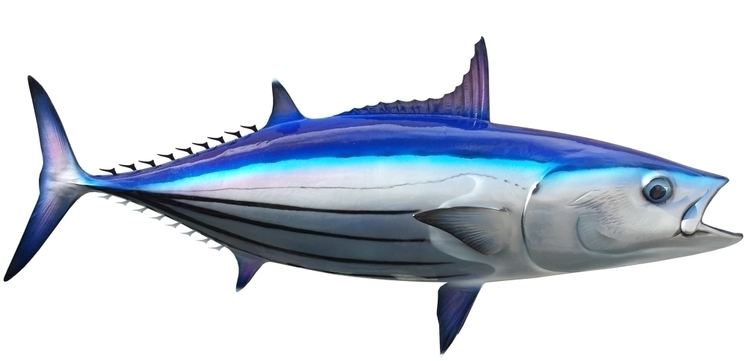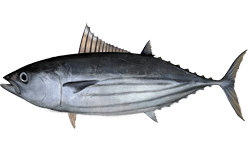Tribe Thunnini Mass 19 kg (Adult) Phylum Chordata | Order Perciformes Scientific name Katsuwonus pelamis Higher classification Katsuwonus | |
 | ||
Genus KatsuwonusKishinouye, 1915 Conservation status Least Concern (Population stable) Similar Katsuobushi, Dashi, True tunas, Tuna, Yellowfin tuna | ||
Sick trolling skipjack tuna action with three and four on at a time
The skipjack tuna, Katsuwonus pelamis, is a medium-sized perciform fish in the tuna family, Scombridae. It is otherwise known as the aku, arctic bonito, mushmouth, oceanic bonito, striped tuna, or victor fish. It grows up to 1 m (3 ft) in length. It is a cosmopolitan pelagic fish found in tropical and warm-temperate waters. It is a very important species for fisheries.
Contents
- Sick trolling skipjack tuna action with three and four on at a time
- Maldives pole and line skipjack tuna fishing
- Description
- Fisheries
- As food
- References

Maldives pole and line skipjack tuna fishing
Description

It is a streamlined, fast-swimming pelagic fish, common in tropical waters throughout the world, where it inhabits surface waters in large shoals (up to 50,000 fish), feeding on fish, crustaceans, cephalopods, and molluscs. It is an important prey species for large pelagic fishes and sharks. It has no scales, except on the lateral line and the corselet (a band of large, thick scales forming a circle around the body behind the head). It commonly reaches fork lengths up to 80 cm (31 in) and a weight of 8–10 kg (18–22 lb). Its maximum fork length is 108 cm (43 in) and maximum weight is 34.5 kg (76 lb). Ageing skipjack tuna is difficult, and the estimates of its potential lifespan range between 8 and 12 years.

Skipjack tuna is a batch spawner. Spawning occurs year-round in equatorial waters, but it gets more seasonal further away from the equator. Fork length at first spawning is about 45 cm (18 in). It is also known for its potent smell.
Fisheries

It is an important commercial and game fish, usually caught using purse seine nets, and is sold fresh, frozen, canned, dried, salted, and smoked. With reported landings of almost 2.6 million tonnes, it was second only to the Peruvian anchoveta as the world's most important capture fish species in 2009. Countries recording large amounts of skipjack catches include the Maldives, France, Spain, Malaysia, Sri Lanka (බලයා), and Indonesia.

Skipjack is the most fecund of the main commercial tunas, and its population is considered sustainable against its current consumption. Its fishing is still controversial due to the methodology, with rod and reel or fishery options being promoted as ecologically preferable. Purse seine methods are considered unsustainable by some authorities due to excess bycatch, although bycatch is said to be much reduced if fish aggregation devices are not used. These considerations have led to the availability of canned skipjack marked with the fishing method used to catch it.

Skipjack is considered to have "moderate" mercury contamination. As a result, pregnant women are advised against eating large quantities. In addition, skipjack's livers were tested globally for tributyltin contamination. TBT is an organotin compound introduced into marine ecosystems through antifouling paint used on ship hulls, and has been determined to be very toxic. About 90% of skipjack tested positive for contamination, especially in Southeast Asia, where regulations of TBT use are less rigorous than in Europe or the US.
As food
Skipjack tuna is used extensively in Japanese cuisine, where it is known as katsuo (鰹 or かつお). Besides being eaten seared (katsuo tataki, 鰹のタタキ) and raw in sushi (寿司 or すし) and sashimi (刺身 or さしみ), it is also smoked and dried to make katsuobushi (鰹節 or かつおぶし), the central ingredient in dashi (出汁 or だし) (a common Japanese fish stock). It is also a key ingredient in katsuo no shiokara (塩辛 or しおから).
In Indonesian cuisine, skipjack tuna is known as cakalang. The most popular Indonesian dish made from skipjack tuna is cakalang fufu from Minahasa. It is a cured and smoked skipjack tuna dish, made by cooking the fish after clipping it to a bamboo frame. Skipjack is also integral to Maldivian cuisine.
